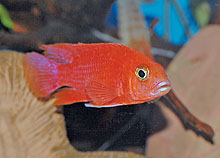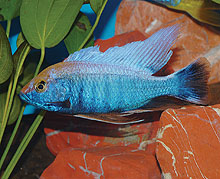WHAT'S NEW ACROSS THE WORLD
Select date in side bar to go to a What's New of previous issues
| What's New
©by Laif DeMason
Summer is now behind us and what a hot one! …well at least in the South! Hopefully autumn’s weather will get hobbyists back to their tanks, fish club meetings, and maybe a fish store or two. Check out some new cichlids or at least what cichlid people are talking about. That’s quite easy with social media nowadays. But remember your own personal tastes and preferences should always guide your way. Don’t forget there is another big Aquatic Experience fish show in Chicago again in early November and the 23rd Cichlid Extravaganza in Cleveland the weekend before Thanksgiving.
Here’s “what’s new” on the cichlid scene: |
Lake Tanganyika
Collecting and export efforts continue from around the lake; all except the Burundi coastline. Hobbyists continue to ask for colorful featherfin and Cyprichromis types; maybe something a bit different than the usual fare please! Wild Tropheus demand is a bit on the downswing as reflected in the lowered prices from importers. However, most wild Tanganyikan fish collected now are being shipped to China!
| WHAT'S NEW: LAKE TANGANYIKA |

An interesting cichlid reportedly from Kapampa, Congo, Cyprichromis sp. ‘leptosoma jumbo’ has been imported recently. Cyprichromis varieties from Congo are difficult to transport and therefore usually not collected. Reportedly, males of this variety sport a yellow body while courting females.
|

Generally collected from the east Zambian coastline, Lepidiolamprologus meeli (previously L. hecqui) can be caught by request. This cichlid is a shell dweller and fanciers of these diminutive cichlids continually ask for a variety of different species to add to their collections.
|

Another diminutive shell dwelling variety is the so-called Altolamprologus compressiceps “shell fish”. Indeed wild adults are usually only one inch (2.5 cm) or less in length. Generally from Nsumbu, Zambia, recent collections were from Mpulungu and Chimba (here) since Nsumbu fish are off limits there now.
|

Dozens of miles of rocky coastline to the north and south of Moliro, Congo, lend to the fact that not all wild Tropheus moorii “Moliro Red” are collected in the exactly same location. Some strains produce fish with strongly red dorsal fins and body coloration, even as small juveniles.
|
Lake Malawi
Ranks of Malawi cichlid hobbyists are starting to increase again worldwide. A few years back many African cichlid hobbyists were mostly interested in Tanganyika. Now demand for wild caught Malawi cichlids (even though quite expensive now) is up, with Europe and China leading the way.

Super colored male cichlids from the southern coast of Tanzania have arrived lately. An interesting cichlid from Undu Point, Tanazania, the so-called “free water” Copadichromis jacksoni is more or less similar to all other populations lakewide but here aggregates seasonally in the water column instead of near shore rocks. (Photo by A. Konings)
|

Another Undu Point fish, Mylochromis sp. ‘lateristriga makanjila’ is also known as Mylo Longnose due to its pointy face and mouth shape. Other Malawi cichlids have a pointy face or profile as well; notably Lichnochromis acuticeps. The fascination for these fish is with the shape of the head and color.
|

Big predator haplochromines from the genus Buccochromis are in demand even though most wild individuals rarely have color on arrival. The one pictured here, B. heterotaenia, at least has a background pattern of black hatch marks.
|

What about Lethrinops types? Again they mostly arrive with little color in males. A recent arrival, Tramitichromis brevis from southern Tanzania, arrived with no color but started to color up in about two weeks. Our other import Lethrinops sp. ‘marginatus chimate’ is still uncolored in their holding tanks.
|

Some of the Malawi cichlid hybrid strains from the Far East often impress with their explosive colors. Pictured here is a man-made Aulonocara or peacock type with a strong candy apple red body color. Likely these strains are not fixed but appear infrequently in mass mixed breeding efforts, not unlike koi.
|

Far East breeders not only work on developing different and unique colorations, but they also select their hybrid for finnage. Pictured here is a Copadichromis Mloto type with well developed long dorsal and ventral fins. This fish is now more likely a target in a mixed African cichlid tank….
|
Select date in side bar to go a What's New of previous issues |









